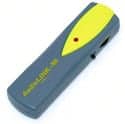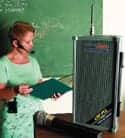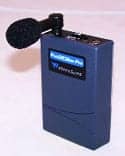Despite whatever Mother Nature throws their way, Enhanced Listening Technologies Corp and Connections Unlimited Inc survive and thrive.
Hearing Products Report recently spoke with Ted Simons, president and CEO of Enhanced Listening Technologies Corp (ELT) and its sibling, Connections Unlimited Inc (CU), about the companies’ beginnings and where he plans to lead them in the future.
Hearing Products Report (HPR): Tell us about the companies.

ELT’s direct customer base for its branded products includes its sibling, CU, plus a number of international distribution partners located throughout Europe, as well as in Australia and Taiwan. ELT also develops and manufactures assistive devices, components, and accessories for them on a private label basis for other companies. CU’s role is as a multi-line wholesale and business-to-business distributor of assistive listening and speech products. It also acts as distributor for ELT’s line of educational headphones and other computer peripheral devices. ELT Design’s role is to reduce our visions, coordinate production, and assure the quality of our goods manufactured in various facilities around the world.
HPR: When and how did ELT get started? What was the company’s vision at the time?
Simons: ELT was born out of necessity and has grown on a diet of needs nurtured by imaginative problem-solving. Prior to the organization of ELT, I had started CU as a sound contracting company. In 1992, the early days after the signing of the Americans With Disabilities Act, we became interested in efforts by the the National Captioning Institute (NCI) to establish a nationwide network of facilities with compatible infrared (IR) listening systems. This led CU to add wholesale distribution, supporting audiologists and other hearing health care professionals in their efforts to promote ALDs, to its list of business tasks.
We enjoyed reasonable success over the next few years, expanding the base of 95 kHz IR compatible ALD systems in theaters and auditoriums in Florida, and adding significant numbers of hearing health care professions to the consumer distribution chain. Unfortunately in 1994, NCI withdrew from the project to focus on its telecaptioning efforts.
About a year later, our primary supplier of IR equipment announced that it would discontinue its 95 kHz product range in favor of a new infrared operating frequency at 2.3 MHz. This decision was predicated on the rising prevalence of and a federal mandate to install electronically ballasted fluorescent lights—which cause interference on the 95 kHz frequency—in government buildings, such as courthouses.
Making such a change would mean that the entire installed base of 95 kHz facilities in the United States—several thousand venues—would become incompatible with the new receivers, yet the facilities where the impact would be predominately felt were places consumers would not typically frequent and where the facility could reasonably provide an alternative receiver. I found this unacceptable because one of our corporate objectives since the outset had been to help build a consumer-friendly, nationwide, and eventually global network of facilities using IR listening systems where consumers could bring their “own” receiver, appropriate for their hearing need, and enjoy the best possible listening experience. It made no sense to me to abandon a reliable system that had been serving consumers at Broadway theaters and other major entertainment venues, cinemas, churches, etc, since 1976. This drastic change would come at a time when the ALD movement was just beginning to achieve critical mass. So, as we correctly believed the venues where most people would use this technology would go unaffected by the new lighting, we decided to develop our own product to support existing and new facilities with this proven effective listening technology.
In developing our product, we preserved the features we liked about the equipment we had been working with, and added improvements and enhancements that we felt the product needed to make it a more effective device for our customers.
HPR: How was ELT affected by the recent hurricanes in the area?
Simons: For nearly 12 years, ELT and CU were located in an old trackside loft warehouse in downtown West Palm Beach, Fla. It wasn’t fancy, but the rent was low and it had a certain charm. Unfortunately, the September hurricanes in 2004 damaged the building considerably and we began to notice an infiltration of mold behind walls in some areas of the building. The decision had to be made to relocate to a healthier facility—with thousands of structures damaged in the area, locating warehouse space after a major hurricane can be a dodgy experience. We did locate new space, but it was less than half the space to which we had become accustomed at a significantly higher cost. Using pallet racks, we were able to stretch almost 1,000 additional square feet of warehousing from a 2,500-square-foot space. This meant, however, that some materials needed to remain in the undamaged portion of the old warehouse until we could absorb them. This meant paying rents on two facilities—an expensive solution, but it was working.
Then this past October, along came Hurricane Wilma. This hurricane really broke the camel’s back. Wilma stripped nearly 60% of the roof off of the old warehouse building. While the new building stood firm, thankfully, the old warehouse was no longer usable and about half the material remaining in the old structure was water-damaged and needed to be discarded.
HPR: Have you been able to recover from that yet or are you still in the process of recovery?
Simons: Until Wilma came along, I could have answered affirmatively, but, for now, Wilma has made daily operation a bit more cramped and difficult. While we made no claims for assistance after Frances and Jeanne, we are hoping to receive some assistance from FEMA following Wilma. If anyone has wondered why some shipments might have been a little late in the fourth quarter, it was, in part, due to clean-up and clean-out efforts at the old facility. What a mess! But the clean-up is complete. Those items that were not damaged or, in the case of equipment, were salvageable, now rest in containers in the parking lot of our new warehouse and will slowly be absorbed into the Riviera Beach warehouse space. Due to the tight quarters, I expect another move or expansion will be coming in the not-too-distant future.
HPR: What are some of the company’s best-known products, what are they designed to do, and who is the target user?
Simons: The very first ELT product was our AudioLink® personal listening system, which was designed to help consumers with a wide range of hearing needs better enjoy television, plays, movies, lectures, concerts, and other public functions that fulfill our human experience. AudioLink achieves this by establishing a wireless link between the source of sound we are listening to and the ear or hearing aid. Essentially, it delivers a front-row listening experience to every seat in the theater or other venue. We now manufacture a wide range of infrared products ranging from personal receivers and TV listening systems to conference listening systems and large venue single- and multi-channel infrared listening systems.

Last year, we expanded our AudioLink brand into the realm of AFILS or LOOP technology by developing induction receivers for patrons of looped facilities who do not wear T-coil equipped hearing aids. We also import a range of British manufactured induction loop amplifiers and test equipment to assure that facilities that elect to use AFILS technology rather than IR or FM can do so competently and assure their patrons the maximum performance possible from this technology. From this range, our PortaLOOP™ rechargeable service counter communication system can be used to help orient and train new hearing aid wearers to use telecoils more competently and effectively.
Our next product range, SchoolPHONES™, was born out of the need for my son’s school to find inexpensive headphones to use in the classroom and computer lab. His first grade teacher didn’t want her students to share headphones for sanitary reasons. As I was in the audio industry, I naively volunteered to find such a product. After repeated failures, it became clear to me that in order to meet my commitment to the school, I needed to do something dramatic. The outcome was to have an appropriate headphone manufactured for schools. SchoolPHONES has evolved into a range of affordable, high-quality headphones and other listening accessories to facilitate the use of multimedia equipment and materials in the educational environment. Our new K-4 style headphone is the smallest compact headphone currently available in the marketplace—it is sized to comfortably and securely fit pre-K students. K-4 is also available in a mono-plugged audiology version for the many schools that continue to use non-BTE personal FM systems for children with hearing loss, ADD/ADHD, and other cognitive processing disorders.

ChatterVOX® is a waist-worn speech amplifier. It was born, again, out of need. I have a dear friend and mentor who suffers from Parkinson’s disease. One of our great pleasures over the years has been going out for lunch and conversation. Unfortunately, as his Parkinson’s has progressed, his vocal projection has been significantly impacted. His vocal loss had reached a point where dishes and other background noises in the diner we frequented were louder than his voice. We could no longer effectively communicate in this environment we both enjoyed. We needed a simple yet effective solution. ChatterVOX is a simple, well-balanced, rechargeable voice amplification system that provides the boost necessary to achieve an intelligible speech level. It has become the benchmark for effective voice augmentation, and we continue to reinvest in its design and technology to achieve new levels of performance.
One of the greatest satisfactions for ELT about ChatterVOX is that it has become a significant tool in education for speech pathologists and audiologists. For speech pathologists, it is a proven tool to conserve, preserve, and aid rehabilitation of the teacher’s voice. School audiologists have discovered it is a most effective aid for children with hearing loss. Not only does it boost the presence of the teacher’s voice in the classroom, but being totally portable, it is also effective for field trips and other activities outside the classroom.
ChatPACK™ was inspired by Houston audiologist Max McCarthy and his associate Les Callaway. It is an outstanding totable soundfield package based on our ChatterVOX amplifier and the Comtek® 216 MHz personal FM system.
Our ChatterBOX™ product category is a group of portable and installed voice amplification and soundfield products based on reliable UHF wireless microphone technology. ChatterBOXes are used in classrooms, hotels, training rooms, and many other venues where high-performance, compact sound reinforcement is needed. This year, we are introducing two new ChatterBOX products, a dual wireless version of our existing ChatterBOX, as well as a dual wireless installed soundfield system we have dubbed ClassACT™.

PT tools™ is a range of microphones and other accessories to boost the efficacy of personal amplification products. It was developed watching hearing impaired friends at the SHHH [Self Help for Hard of Hearing People] conventions plug and patch their way to communication solutions using every imaginable gadget they could get their hands on. They have learned, and all audiologists know, that the hearing aid cannot solve every listening problem. There always are and always will be environments and situations in which the hearing aid, by itself, is simply overwhelmed. PT tools can be an effective component of a comprehensive hearing rehabilitation program. They provide the necessary implements to enhance listening strategies and management of signal to noise in the listening environment.
HPR: The company also has a line of sanitary products for the company’s assistive listening devices. Would you talk about those products and why the company offers them?
Simons: Call me a student of Bob Kemp of Oaktree Products and the good folks at Comply on this one. We offer sanitary care and maintenance components for our entire product range. These include cerumen filters and hygienic silicone earpads for our AudioLink stethophones, and disposable fabric and foam covers for our various other headphone products. In this era of increased concern about virile pathogens and parasites, I think it is critical that ALD manufacturers act responsibly and aggressively to underscore the need for good aural hygiene. We intend to lead on this front.
HPR: How does ELT identify and respond to needs in the hearing health care field?
Simons: ELT, ELT Design, and CU are committed to and involved in the hard-of-hearing community. I have personally been involved with SHHH for more than 10 years, coordinating ALDs for their national convention and teaching some of their ALD programs. It is the finest venue imaginable for learning about the daily challenges of living with hearing loss. It costs me, and our development engineer, Hans Roesler, a week of sleep once a year, but it is an experience we would not trade and a learning opportunity we could not replace. We “counselors” have affectionately dubbed the convention “Camp Whadyasay.” The wonderful SHHHers put up with our silliness and generously teach us more about hearing loss and their needs.
I am also a proud board member of the Hearing Rehabilitation Foundation. There I have the privilege of working with and learning from some of the world’s foremost thinkers, practitioners, and scientists in the field of hearing rehabilitation. I urge all audiologists to learn more about this wonderful organization and its biannual conferences.
I also have been, and continue to be, mentored and encouraged by some of the great individuals of the hearing equipment industry.
HPR: What sets the company apart from its competitors?
Simons: As a privately held company, we enjoy a freedom to pursue marginally profitable projects for extended periods of time because we believe in their ultimate success and value to our customers. Public companies that live under the constant pressure of quarterly financials have difficulty with this. This conservatism often provides us with opportunities.
Because of our small size, we stay close to the problem. None of our staff is isolated from the daily needs of our clientele. Everyone gets involved in customer service. This, too, is difficult for larger organizations.
Further, we have developed a unique development/production strategy. We team with a number of small to medium sized manufacturers, engineers, and designers around the world. Each has their talents and capabilities. Most, outside their work with ELT Group, have no history or business base in the hearing industry, therefore they have no prejudices or inhibitions about what can and cannot be achieved. We blend [their ideas] like recipes to innovate and create imaginative solutions. You will often see that we reference our products as produced by ELT Group. These products really represent a global consortium of engineering and manufacturing talents. I know of no company, of any size, that can bring together more diverse and competent talents than ELT.
HPR: Do you run ELT under a certain business philosophy?
Simons: Identify the need. Technically meet the need. If we don’t know how to do it, collaborate with the best people and companies we can find. Then, work backward to achieve the highest possible equilibrium point between cost and performance. Never, never lose sight of the consumer who will live with the technology. Live by the KISS principle. Be passionate.
HPR: Has ELT changed over the years?
Simons: ELT is a scrappy “teenager” right now, suffering typical teen growing pains, but filled with enough vinegar and imagination to achieve greatness. What started as a small company’s need to replace a key product in its contracting business has grown into an expanding range of exciting niche products. It has also led to an ongoing search for new technologies and solutions to enhance living and communication for individuals with impaired hearing and speech and those with whom they interact every day.
HPR: What are your plans for ELT’s future?
Simons: Listening and speech enhancement will continue to be our areas of focus. Our existing products will continue to evolve, and we will strive to make them and new products that arise from our expanding knowledge/experience base more and more effective.
We have a lot of dreams at ELT and notebooks filled with new product ideas. For 2006, my goal is to get back on schedule after the setbacks of the 2004 and 2005 hurricanes and convert more of these product concepts into solid 3D material. There will be significant new entries in our AudioLink, ChatterVOX, ChatterBOX, PT tools, and SchoolPHONES ranges as quickly as we can fund their final development stages and schedule production.
I would like to focus on developing more strategic alliances in our industry and the hearing, speech, and education professions. I want to raise the visibility of our brands, ELT Group, and our corporate identity, and expand the availability of our products to consumers by growing our branded and OEM distribution network.
We do, and will continue to, strive to be the kind of company that provides products and services that hearing, speech, and education professionals can rely on. Further, we want to collaborate more with these professionals to improve how technology serves each of these professions and their clientele.
We are small and agile; that makes us a good partner for larger companies that want to fast-track an idea that would move too slowly though their larger and more bureaucratic structures. Our ELT Group network, as I said before, also makes a wide range of engineering and manufacturing talents available.
I, personally, am excited about ELT’s future and very happy to be a part of an industry and professional community that has such a great capacity to enhance the human experience of life. N





